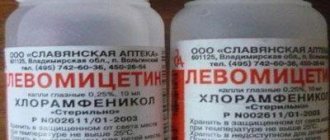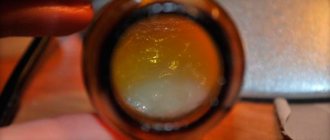Irritation under the nose from a runny nose, how to remove redness?
Long-term colds (acute respiratory infections, acute respiratory viral infections) are usually accompanied by rhinitis.
With frequent blowing of the nose, an acute inflammatory process of the skin around the nasal area occurs - dermatitis - irritation from a runny nose. The delicate skin in the nose area, especially under it, turns red, there is slight swelling and a feeling of pain when touched. If the irritating effect of nasal mucus continues for a long time, small watery bubbles form.
After the “blisters” are opened, a raw (erosive) surface is formed, covered with a light, brownish crust. Irritation from a runny nose quickly goes away when the provoking factor disappears.
There are not many reasons for the appearance of redness, or even ulcers, under the nose and on its wings; let’s look at them in more detail.
Inflammation of the skin from a runny nose can occur against the background of allergic reactions or a too dry climate. The main cause of irritation under the nose from a runny nose is mucus flowing from the nasal cavity.
Snot (muconasal mucus) consists of 90% water, 10% is mucin protein and various salts. With a constant profuse runny nose, it is the salt component that has an irritating effect on the skin.
Paranasal dermatitis can also be caused by intense friction from frequent use of a scarf or napkins to remove snot. It should be noted that the appearance of irritation under the nose and the duration of healing largely depend on the immune system.
In a person weakened by chronic diseases, exhausted and experiencing “vitamin hunger,” the manifestations of skin irritation under the nose are most pronounced.
To successfully treat irritation under the nose, you need to eliminate the cause that caused the dermatitis (acute rhinitis, sinusitis, various allergies). The patient should eat well and be sure to take multivitamins. Nasal mucus should be blotted, not wiped, and blown with caution.
During the period of acute development of irritation, the use of lotions with tannin, resorcinol, and calcium pantothenate in the form of solutions is effective. Moisten a cotton pad or gauze swab with the medicine, apply to the site of inflammation, and hold for 40–50 minutes. Repeat the procedure two more times a day.
You can use cold tea leaves for lotions and change the tampon (or napkin) as it warms up. The use of cold herbal infusions is recommended by traditional medicine. Chamomile, sage, yarrow, calendula flowers and eucalyptus leaves are herbs used for infusions.
When the phase of acute inflammation passes, the erosive crusts become soaked, you can begin using anti-inflammatory creams and ointments. Apply medicinal ointments in a thin layer, preferably in the morning and evening before bed. “LorindenS”, “Ftorokort”, “Flucinar”, hydrocortisone and ethonium ointments are medications recommended for skin irritation.
A quick healing effect is achieved with regular use of Lassara paste. For irritation that causes severe itching and runny nose of an allergic nature, the use of Prednisolone and Deperzalone is indicated. Any vegetable oils, rosehip and sea buckthorn oils are good for a runny nose due to irritation; smear the area under the nose throughout the day.
The oil film prevents additional skin irritation and has disinfecting properties.
If you have a severe runny nose, it is advisable not to use a handkerchief; it is better to switch to disposable paper napkins and handkerchiefs. Do not “rub” your nose when there is discharge, but carefully blot it; you can use wet wipes soaked in cream.
When using fabric scarves, choose a soft material and change often; a “dried” scarf is a breeding ground for infection and a traumatic factor. To prevent irritation under the nose, it is better to blow your nose under warm tap water. Water does not irritate or injure the skin, and easily washes away any remaining mucus.
Applying any fatty cream, maybe baby cream or Vaseline, will help protect the area under the nose from frequent rubbing during an intense runny nose.
Fleming's ointment
Thuja ointment
Oxolinic ointment for children
Calendula ointment: application
Levomekol ointment
Nasal ointment
· You will need to read: 5 minutes
Many men and women are familiar with such a common problem as redness and flaking of the nose. This especially causes great discomfort and inconvenience to representatives of the fair half of humanity. If a certain part of the body can always be covered with clothing or an accessory, then the nose is always visible.
Typically, redness under the nose occurs due to external factors such as sunlight, wind, temperature changes, etc. With proper facial skin care, irritation should go away within a couple of days. In any case, it can be both a medical and cosmetic problem, accompanied by other unpleasant symptoms, such as:
- swelling of the nose;
- pain;
- peeling near the wings of the nose;
- itching;
- feeling of tightness.
But if you notice that all your efforts during the week do not give the desired result, then it’s time to visit a doctor. The main thing in this matter is not to delay, because redness of the skin may indicate that pathological processes are occurring in the body, which can bring you a lot of unpleasant sensations and harm your health.
While you have not yet decided how to treat this problem, you need to try to understand the root cause of the body’s dermatological reaction and determine the source of the redness. There are currently several common causes that can cause flaking and redness in and around the nose. Let's look at them in more detail.
Very often, redness of the skin around the nose and peeling can be a consequence of damage to the body by influenza viruses, acute respiratory infections, a runny nose or a cold. During illness, there is a strong discharge of mucous fluid. Since the patient often tries to wipe away, simply put, “snot,” this leads to the skin on and around the nose becoming inflamed, and swelling also appears.
It is recommended to rinse the nasal canals with warm sea water or water with the addition of sea salt, and apply special healing creams that have an anti-inflammatory, softening and regenerating effect to the skin of the face. Irritation under the nose from a runny nose should be treated with a moisturizer with chamomile extract, or other anti-inflammatory agents, only after neutralizing the copious mucus discharge from the nose.
Irritation under the nose can be caused by the body's reaction to a certain disease and can spread throughout the face. An allergic reaction is accompanied by the appearance of unpleasant itching and swelling of the skin. Therefore, in this case, you should not look for the cause of the redness yourself and risk your health.
We invite you to familiarize yourself with the Carboxytherapy Set for Oily Skin
Redness of the nose from a runny nose treatment
Blowing your nose frequently if you have allergies, a cold or flu, or in a dry climate can irritate your nose. The delicate skin around the nostrils can become dry and cracked due to constant nose blowing and wiping.
This can be especially problematic with allergies because they last longer than a cold or flu.
No matter what the cause of your runny nose, the following tips will help you soothe irritation and protect your nose from a runny nose.
Apply a soothing moisturizer around your nostrils. Products such as Vaseline and Neosporin work best in such cases.
Apply a small amount to the tip of your nose and then spread it outward at the entrance to each nostril.
Adding extra hydration to these areas will not only help combat dry skin and discomfort, but will also prevent nasal discharge from irritating your skin. [1]
- If you don't have Vaseline or Neosporin on hand, you can use regular moisturizer. It won't create as effective a barrier, but it will still provide some relief.
Buy special wipes with lotion. [2] If you're willing to pay a little more, invest in high-quality facial wipes that hydrate your skin.
Look for wipes that have been treated with a special lotion. They cause less damage to the skin around your nostrils when you blow your nose, and the soothing lotion helps reduce irritation.
Remember, the less you wipe and rub your nose when you have a runny nose, the less irritation there will be.
A runny nose can be called one of the most unpleasant symptoms of colds, viral infections and allergies. When you have a runny nose, breathing becomes difficult, mucus is released abundantly from the nose, the nose swells, turns red, itches and becomes very thin. That’s why I want to get rid of a runny nose as soon as possible. Are there ways to deal with a runny nose quickly? Let’s figure it out together.
Regularly rinsing your sinuses helps get rid of a runny nose much faster. The advantage of this procedure is that it does not require any special pharmaceuticals - the washing solution can be easily prepared at home.
To prepare the solution, you need to take a glass of boiled water and dissolve one teaspoon of sea salt in it. When the salt has completely dissolved, pour a small amount of the solution into your palm and begin to draw it into your nasal sinuses with your nostrils.
After sucking in, blow your nose.
You can enhance the healing properties of the solution by adding a couple of drops of eucalyptus essential oil or propolis tincture.
Instilling medications into the sinuses is one of the effective ways to quickly overcome a runny nose. Drops for instillation can be purchased at a pharmacy, but before purchasing pharmaceuticals, consult a physician. A professional doctor will help you choose an effective and reliable remedy for the common cold.
We suggest you familiarize yourself with a lump on the forehead under the skin - what it is and how to remove the lump
Instillations can also be carried out using traditional medicine. A runny nose can be effectively treated with aloe juice instillations. The procedure is carried out as follows: you need to drip three drops of plant juice into each nostril. Repeat instillation after three hours until the runny nose disappears completely. Aloe juice clears sinuses and kills harmful bacteria.
Cleansing the body at home
First of all, in order to eliminate redness on the nose, you must understand that this is simply a dilatation of blood vessels, which you can easily cope with on your own at home, or demodicosis, which you need to immediately consult a doctor about.
In order to understand this, pay attention to the state of the body as a whole.
It often happens that menstruation, severe anxiety, stress, digestive disorders, colds, and anemia can also cause redness of the nose.
Another fairly common reason for this may be inflammation of the hair follicles with pustules in the nostrils. In this case, treat the underlying disease. The redness of the nose as a consequence will go away on its own.
If the redness is not caused by any of the above diseases, but simply by local vascular disorders and enlarged pores, then radically reconsider your diet. Remember that a rush of blood causes excessive overeating. In addition, the nose may turn red after strong coffee, tea, too hot dishes, alcohol, or spicy foods.
If your nose reacts to sudden changes in weather, then try hardening it. Then he will blush less. Prepare a decoction of chamomile or sage. Make compresses or baths twice a week. Moreover, alternate a hot compress with a cold one.
Finish the entire procedure cold. In winter, do not walk lightly, and in summer, try not to be exposed to direct rays of the sun. Before going out into the cold, try to coat your nose well with melted duck or goose fat from the inside and a little outside.
Then powder it so it doesn't shine.
Try making a decoction of linden blossom. Wipe your nose with it every morning and before bed. In addition, in the morning, preferably standing by an open window, do exercises for your nose: alternate strong and short nasal inhalations and exhalations. Wash your face with water at room temperature. Perform a light massage with your fingertips.
How to get rid of post-acne on your face
Until recently, diseases of the respiratory tract were divided into two types - diseases of the upper respiratory tract (they were dealt with by ENT doctors) and diseases of the lower respiratory tract (pulmonology).
Recently, in world medicine, diseases of the respiratory tract have not been distinguished, since the respiratory organs are inextricably linked and problems in the upper sections entail problems in the lower sections of the respiratory tract.
Almost all diseases of the ENT organs, with the exception of anatomical abnormalities, are one disease only at different stages of evolution. Most of them start with nasal congestion.
The causative agent is an infection that provokes degenerative changes in the nasal mucosa and disorders of local immunity.
The human respiratory tract consists of the nasal cavity, paranasal sinuses, oral cavity, oropharynx, trachea, and bronchopulmonary tree.
https://www.youtube.com/watch?v=0swkwpejopw
The nose, in addition to its aesthetic value, has important functional significance as an organ. Nasal breathing is of enormous importance for the normal functioning of the entire respiratory system, and it is especially important for the regulation of cerebral circulation. Impaired nasal breathing in children leads to disruption of the formation of the chest and skeleton.
Therefore, it is important to promptly notice diseases of the ENT organs and treat them correctly, which will avoid a number of health problems in the future. Nasal congestion is a signal of the beginning of an inflammatory process in the upper respiratory tract. This is usually rhinitis, sinusitis. In children it is adenoiditis.
There are many reasons for nasal congestion. Consult your doctor for a more accurate diagnosis!
Delayed consultation with a doctor leads to chronicity of the inflammatory process, which leads to chronic sinusitis, chronic rhinitis, and adenoid hypertrophy.
Nasal congestion occurs with injuries to the nose, with acute respiratory infectious diseases. There is also a separate nosology called rhinosinusopathy of pregnancy.
During pregnancy, hormonal changes occur that cause nasal congestion.
If irritation has already appeared, measures must be taken as soon as possible to avoid secondary infection. Anti-inflammatory ointments will help relieve pain and redness; you can use products with herbal ingredients, for example, sea buckthorn oil or aloe extract.
You can also use regular baby cream, but due to the content of menthol and eucalyptus oil, when applied it can cause an unpleasant sensation - tingling or burning, especially if the skin is severely damaged.
Light moisturizing creams, sesame, almond or peach oils help relieve irritation well - apply them to the affected skin in a thin layer as needed, being careful not to rub. Any rubbing will only increase inflammation, so try to touch painful areas as little as possible.
If the inflammatory process was not stopped in time, cracks appeared on the skin near the nose, and redness spread to the upper lip, it is better to consult a dermatologist. The crusts that appear cannot be peeled off - as a last resort, carefully separate them, after smearing them with Vaseline or cream, and then apply healing agents to the skin.
If you have a severe runny nose and nasal discharge irritates the skin, try not to wipe it away, but to gently blot it.
https://www.youtube.com/watch?v=iqqa2zpolsi
You should not use tissue handkerchiefs - it is better to stock up on paper napkins or handkerchiefs, preferably made of soft, non-scented paper. You can also use wet wipes with lotion or cream.
Textile scarves, if you do use them, choose soft material and change them as often as possible.
If you have to frequently blow your nose and wipe your nose, you can apply any greasy cream or Vaseline to the skin near the nose - it will protect the skin from excessive friction.
Tags: runny nose, anoint, after
« Previous entry
How to deal with a runny nose
A runny nose is an irritation of the nasal mucosa, which contains a large number of microbes. They are the cause of a runny nose, which appears when a person’s immune system is weakened. At this time, microbes actively multiply, irritating the mucous membrane. The body's defensive reaction begins - a runny nose, which removes microbes along with the liquid. This is probably the most unpleasant consequence of decreased immunity.
Instructions
- When a runny nose appears, you must first fight its cause, that is, increase your immunity. Take vitamins, eat more fruits and vegetables, eat healthy. A runny nose, as a rule, occurs in the cold season, when cooling the body leads to a decrease in protective reactions. Underestimating the weather, people dress poorly and quickly catch colds. Dress warmly and protect your feet from getting wet.
- Vitamins, proper nutrition and warmth alone will not cure a runny nose once it has already appeared. To do this, it is necessary to influence the nasal mucosa. A proven folk remedy for treating a runny nose is inhaling onion vapor. Chop a regular onion and breathe over it or rub a slice of onion under your nose if you are not afraid of irritating your eyes and skin. Garlic is also effective in treating a runny nose by killing germs in the nose. Add onions and garlic to your food and inhale their vapors.
- Fir and eucalyptus oils are also good for treating a runny nose. Dip a cotton swab into the oil and lubricate the inside of your nose. Nasal congestion will immediately go away, and the oil vapor will begin to have an antiseptic effect. Repeat this procedure two or three times a day. The main thing is that the oils are natural.
- A popular method of treating a runny nose is inhalation. Boil water in a saucepan, lean over it and cover your head with a thick towel, ensuring a tight seal. Breathe for ten minutes until the water cools down. You can do inhalations over herbal decoctions or potatoes. It is also useful to add eucalyptus oil to water. For inhalations, iodine is sometimes used (ten drops per pan) or spruce buds, which are placed in water and boiled for at least five minutes. There are also special devices for inhalation with funnels.
- An old folk method for treating a runny nose is rubbing, which artificially warms the skin. Rubbed, as a rule, with vodka, alcohol or plant settings. After rubbing, wrap yourself in a woolen scarf and cover yourself with a blanket.
- The bath also helps the runny nose disappear. Go to the bathhouse, take a solution of eucalyptus essential oil with you into the steam room and splash it. Do not go to the bathhouse under any circumstances if you have a fever. After the bath, provide yourself with good protection from the cold.
- A runny nose can also be treated with conventional medications – modern nasal drops and sprays. If you use them together with folk remedies, you can quickly get rid of a runny nose. You can also drip a solution of iodine and salt with eucalyptus oil into your nose. An old remedy that helps combat nasal congestion is “Star” balm, which should be spread under the nose.
KakProsto.ru>









